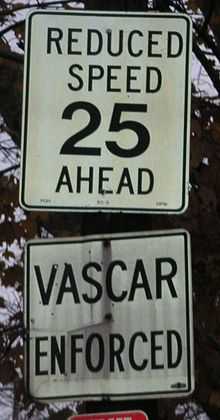VASCAR

VASCAR (Visual Average Speed Computer And Recorder) is a type of device for calculating the speed of a moving vehicle. The first VASCAR device was created in 1966 by Arthur Marshall.[1] It is used by police officers to enforce speed limits, mainly in jurisdictions in Pennsylvania[2] where radar or lidar is illegal, or to prevent detection by those with radar detectors.[3]
Operation
A VASCAR unit couples a stopwatch with a simple computer. An operator records the moment that a vehicle passes two fixed objects (such as a white circle or square painted on the road) that are a known distance apart. The vehicle's average speed is then calculated by dividing the distance by the time. By applying the mean value theorem, the operator can deduce that the vehicle's speed must equal its average speed at some time between the measurements.
VASCAR can be used from a moving or stationary patrol vehicle, and the target vehicle may be travelling in the same direction, in front of or behind the officer. It can be approaching from the front, or even on an intersecting highway. This technique can also be used to determine a vehicle's speed from helicopters and other aerial platforms, making it easier to secure a conviction.
A 1991 study by the National Highway Traffic Safety Administration found that VASCAR-plus units produced errors of less than 2 mph if used correctly.[4]:xiii
History
VASCAR was invented by Arthur Marshall, a real-estate investor living in Richmond, Virginia in 1966.[1] He was inspired to create the device after watching a police car driving dangerously trying to pace a speeder.[5]:181 The original version of the device was entirely mechanical, using a governed motor and a gear system to move a pointer to the correct speed value.[5]:181 Subsequent versions used a microprocessor to perform the speed calculations.[1] By 1968, the device was in use in North Carolina,[6] Indiana, Kentucky, and New York.[5]:181 In 1971, Marshall formed a company, Traffic Safety Systems, Inc., to market the device.[1][7] After his death, Traffic Safety Systems was purchased by Power Systems & Controls, Inc., which had long manufactured the devices.[1] They continue to produce similar devices under the name VASCAR-plus.[1]
Similar devices
While the name VASCAR is no longer trademarked,[8] Power Systems & Controls holds the trademark to VASCAR-plus.[9] Other companies sell similar, though non-VASCAR-branded, systems. For example, under the category "electronic speed timing devices (nonradar), which calculate average speed between any two points", the Pennsylvania Department of Transportation authorizes two devices in addition to the various VASCAR-plus models: the Tracker, by PATCO, and the V-SPEC, by YIS/Cowden Group.[10]
See also
References
- ↑ 1.0 1.1 1.2 1.3 1.4 1.5 Allcott, William (August 1, 1987). "A Better Speed Trap". Richmond Times-Dispatch.
- ↑ Fuoco, Michael (April 28, 2002). "Local police use radar in 49 states, but not here". Pittsburgh Post-Gazette.
- ↑ Peterson, Craig (June 20, 2010). "Blast from the Past: VASCAR Returns". Retrieved January 4, 2011.
- ↑ Analysis of VASCAR (Report). National Highway Traffic Safety Administration. 1991.
- ↑ 5.0 5.1 5.2 Lincoln, Marshall (August 1967). "Watch It, Speeders!". Popular Mechanics.
- ↑ "The Highway: Versatile VASCAR". Time. February 9, 1968.
- ↑ "Company Profile". Traffic Safety Systems, Inc.
- ↑ U.S. Trademark 72,235,004
- ↑ U.S. Trademark 74,566,845
- ↑ "Approved Speed-Timing Devices and Appointment of Maintenance and Calibration Stations". Pennsylvania Department of Transportation. December 26, 2009.